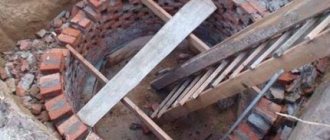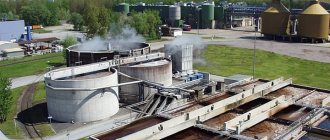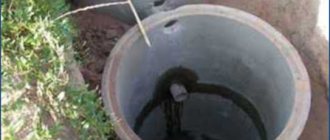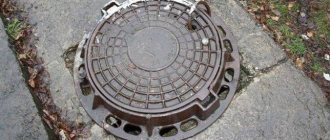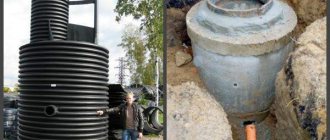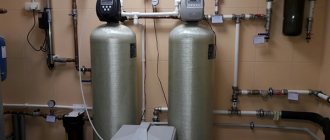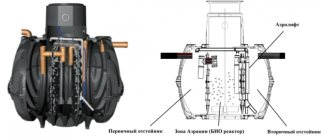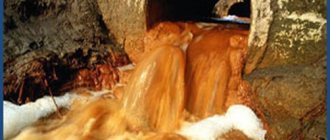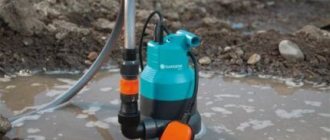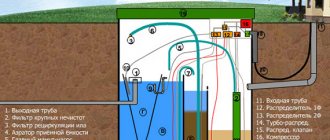In this article:
- Types of sewer wells
- Situations that require drain cleaning
- 7 Methods for Cleaning Sewers
- Factors on which the cost of cleaning a sewer well depends
- 3 Ways to Reduce the Frequency of Drain Cleaning
Drain cleaning jobs can vary in both the methods used and the urgency. Moreover, the choice of option itself often depends on whether the cleaning is planned or emergency. It is clear that it is better not to bring the matter to the last minute.
However, information about existing methods of cleaning sewer wells will not hurt in any case. At least to know whether it is possible to resolve the issue yourself. And if not, then in order to get an idea of the approximate cost of the work.
Types of sewer wells
There are several types of sewer wells. We will look at storage and filtering. All of them consist of a working container, a neck and a lid, and the distinctive feature of each is the structure of the bottom.
A storage sewer well is a large sealed tank into which all used liquid flows through the sewer pipes from the house. Its size depends on the number of people living and the volume of water they use. As soon as the liquid level in the well reaches a critical level, the operation of a sewer (sludge sucker) is necessary to clean the sewer well of silt and excess waste. The pumped out liquid is taken to a specially designated place.
The filter well is designed without a bottom; its role is played by a special multi-stage layer, for which broken brick, crushed stone, and gravel are used. The water, passing through the filter created in this way, is purified, and the well fills much more slowly. If the groundwater level rises, cleanup will definitely have to be called. If the groundwater level is high, preliminary wastewater treatment is necessary.
There is another type of well - a septic tank, a modern multi-stage treatment. To put it into operation, it is necessary to involve engineers and installers. You need to create a project and only then proceed with installation and commissioning.
Auxiliary techniques
When cleaning a well, you must wear a mask and gloves.
To clean wells with persistent contamination, additional methods are used:
- heat treatment;
- use of chemicals;
- manual cleaning.
The first method is similar to purification using hydrodynamics, but the water flow supplied under pressure is heated to 120–160 degrees. Hot water better removes hardened deposits and layers of fat. The method is used only in complex cases, since it is technologically difficult to implement.
When treated with chemical reagents, dirt and fat deposits are destroyed at the molecular level. Chemical substances are in a foamed state. This makes it possible to clean the bottom and vertical surfaces of the sewage tank. The chemical method is effective and does not harm the environment and human health, but is rarely used due to the high cost of cleaning agents.
The manual method allows you to achieve complete elimination of any formations. Cleaning is carried out manually after pumping out the wastewater, when no more than a cubic meter of sediment remains at the well bottom. The deposits are cleaned off with a spatula and removed from the tank using a regular bucket.
Toxic volatile substances are formed in sewer settling basins. When manually cleaning a well, you must carefully follow safety rules and wear specialized equipment: protective masks, gloves. On the surface, at least two people must insure the worker.
Situations that require drain cleaning
The earth does not have time to absorb all the incoming liquid, even with a drainage system in the septic tank. Sewage wells need to be cleaned periodically. And in order for this to happen quickly and easily, even at the construction stage, collector tanks are placed close to the road. It is important that a special vehicle can easily approach to pump out the septic tank.
Cleaning can be planned or emergency. Scheduled cleaning of the sewer well is necessary when the volume is filled to more than 75%. At the same time, if these activities are carried out regularly, no difficulties will arise in the operation of the septic tank. But if this is not done, the septic tank may overflow and flooding of the site and the surrounding area will occur. In this case, emergency pumping of the sewer well is inevitable.
This is labor-intensive and complex work, since after the well overflows, the sewer pipes become clogged with drain plugs. You will have to clean them too.
By neglecting routine inspection, you can expect that over time the pipe will become clogged with small debris, on which a layer of silt will build up. A blockage forms, making it more difficult for sewer water to pass through, and it fills the tank, overflowing it ahead of schedule. This is why it is so important to do routine septic tank cleaning.
Where does waste come from?
In the process of life, every organism that eats and drinks releases some kind of waste, most often biological, .
Man manages to produce more waste than other living organisms .
- leftover food (when washing dishes);
- fragments of materials (when washing clothes);
- hair and skin discharge (during water procedures);
- other biological secretions of the human body .
Almost all waste products contain solid compounds that have the ability to accumulate , clog the sewer system and interfere with its normal functioning.
Factors on which the cost of cleaning a sewer well depends
You can actually deal with some sewer system clogs yourself. However, professional equipment and specialists are required to clean the entire system. Flushing sewer pipes, pumping a septic tank from a well, or using chemical reagents with your own hands will be difficult, troublesome and time-consuming, and possibly ineffective.
To solve this problem, it is better to use the services of a professional service. Of course, this is not a cheap pleasure, but it is necessary. Let's look at what the cost of cleaning a sewer well consists of.
First, the state of the system. Preventative regular washing will be cheaper than the first one done in a year or two. Therefore, it is necessary to carry out cleaning at least once a year. This will be enough to avoid overflow or deposits or traffic jams. This means that you will not need to resort to emergency cleaning services, and the price for scheduled cleaning of a sewer well is much lower than force majeure. Accordingly, a reasonable approach to maintaining the system will reduce your cost item in the future.
Secondly, on the method of cleaning sewer wells in a private house. We have already discussed above that, for example, the chemical method will be more expensive. The flushing method itself is chosen by a specialist based on an inspection of the sewer system and analysis of the data obtained.
How to clear a clog with a cable
Read more
Thirdly, the distance from the city center. If the house or cottage is located far away, then fuel consumption on the road increases, which means this will be included in the cost of cleaning. Plus the time spent on the road. Prices may vary, but if you take the average, cleaning a sewer well will cost around 5,000-7,000 rubles.
Most owners carry out cleaning by involving specialists. This is the key to efficiency, speed and professionalism.
Question details
Cleaning a well in different ways
Depending on the scale of contamination, scheduled or emergency work, there are different cleaning methods:
- 1.With the involvement of a suction pump.
- 2.Using a vacuum.
- 3.Hydrodynamic cleaning.
- 4. Chemical means.
- 5.Removal of deposits using thermal cleaning.
Sludge cleaning
A sludge pump is a small machine equipped with a pump for pumping and a tank for collecting and transporting waste. The pump power is much less than vacuum ones, but they can also cope with cleaning a septic tank. Sludge suckers are used for cleaning all types of sewers and pipes made of various materials; they are also designed for transporting waste residues for disposal. This type is suitable for cleaning in different climatic conditions, is distinguished by its efficiency, the disadvantages include the strong smell of waste during the cleaning process.
Vacuum cleaning
The vacuum pump is particularly powerful and quickly copes with cleaning wells and removing waste residues. After pumping, wastewater is disposed of. Vacuum pumping does not harm the environment and meets sanitary requirements.
Important! To ensure the uninterrupted operation of the entire sewer system and to prevent accidents on sewer lines, it is necessary to carry out scheduled cleaning of wells on time.
Hydrodynamic flushing
This type is considered a simple method for cleaning wells; it is used after waste water has been removed from the well. Using hydrodynamic cleaning, all adhering waste is washed off from the walls of the well with high pressure of water, then the collected sewage is disposed of. One or two machines are involved in the cleaning process, it depends on the volume of accumulated dirt. The first machine is a sewer washing machine and a suction pump. A sludge pump is used if the volume of work is too large.
Attention! Removing deposits using hydrodynamic cleaning is effective if cleaning activities are carried out continuously.
Chemical cleaning
The method involves cleaning with the help of strong chemicals that can dissolve even hard deposits in the form of salts and limescale deposits, rust, and fatty deposits that vacuum cleaners are not able to remove. Using a suction pump, a hose is immersed into the well of the sewer network. Cleaning with chemical reagents is considered a safe cleaning method, but expensive, so it is rarely used.
Removing deposits using thermal cleaning
During cleaning, they use water pressure heated in the range from one hundred and twenty to one hundred and sixty degrees; this method involves the use of special equipment, which is very unprofitable from an economic point of view, so the method is practically not found in everyday life. The method can be used if scheduled cleaning is carried out regularly. The effectiveness of the method increases if it is used together with chemical reagents.
Cleaning domestic drains with water
If it is necessary to flush a domestic sewer with a small volume of waste deposits, water cleaning is used. The hole in the sewer well is covered with a plug, and a large amount of water is poured onto it, creating a certain pressure. Having opened the well, water rushes under pressure into the well and flushes it.
DIY cleaning
The final step of any cleaning method is hand cleaning. Machine cleaning carries out superficial work, without delving into details, in order to improve the cleaning result, cleaning work is performed by hand.
Storm drainage system
Storm sewerage is a complex of pipes, trays, and tanks. They ensure the collection and movement of rainwater to places of disposal and discharge. There are two types of LC:
- external (or open). It is a network of trays (gutters) through which water flows to the treatment plant. Cleaning open-type storm drains is simple, but the system itself does not allow the surface to be used for household needs;
- underground (closed). It consists of pipes laid in the ground at a certain depth. Cleaning closed storm drains is more difficult, but the surface can be used for any purpose.
It is difficult to encounter a completely open or closed LC. Usually combined systems are built, consisting of sections of both types. The parameters of these parts are the same and provide equal throughput. The only difference is the placement method.
Measures to prevent blockages
Experts recommend checking the operation of open storm drains and removing accumulated debris at least 2 times a year. After the autumn leaves fall, you need to remove all debris to prepare the drainage system for winter, and in early spring, make sure the integrity of the fastenings after frost and thaw.
But when there are tall trees near the building, you will have to look at the roof much more often if you do not want to find out about the need to clean up the water flowing down the walls and from the roof of the house, bypassing the rain pipes. But if all the gutters are in a closed type structure, one inspection per year is quite enough.
Rain storage tanks, sand traps, and protective gratings for open gutters will help reduce the frequency and duration of storm drain maintenance
The following preventive measures will help prevent blockages:
- Special canopies for funnels and fine-mesh meshes/grids covering gutters will help reduce the amount of debris entering the drainage system. If the system is already installed and there is no desire to modernize some of its elements, you can fill the gutters with porous foam. It is applied by spraying, takes the form of a drain and does not allow large debris to enter the pipes (however, such protection needs to be updated every 3-5 years).
- Since an external storm drainage system is much easier to clean than an underground one, you can equip the drains with several catch grates that will stop soil particles, sand and leaves. To prevent blockages, it will be enough to regularly check the “control points” and remove debris from them.
- If a closed or mixed type system is installed on your site, it is worth installing grease traps in the pipes that lead household wastewater out of the house. This will help avoid difficult-to-remove formations on the walls of the sewer.
- If the underground part of the system has complex turns, it is worth installing inspection wells in potential places of blockages, so that if problems arise, you do not have to dig up the pipes.
In addition to additional protection of the system, it is worth taking care of wastewater treatment. To do this, you need to equip sedimentation tanks with drainage fields or separators that mechanically separate water from sediment and other impurities, or install an autonomous sewage system.
Signs of contamination
You should start by recognizing the signs of contamination. After all, each type of blockage has a special approach and cannot be eliminated using a universal template.
The appearance of muddy water, even in a very small volume, almost always indicates that soil particles are entering the well cavity. Their penetration there becomes possible due to the weak tightness of the wall joints, which can move or become leaky. It is much worse if the water takes on one color or another.
- A green tint indicates that the well has become a place of active reproduction of microscopic algae. And if the liquid turns black, this most often allows us to conclude that organic matter not only got inside, but is also decomposing.
- Water with an excessive concentration of iron turns yellow; You should immediately keep in mind that ordinary cleaning is powerless in such a situation. Purification through special filters helps to cope with excessive saturation of well water with iron. A specific taste, which appears even before obvious visual signs, also helps to recognize “strong” metal.
- At the dacha and in the household, the water raised from the well may be sweetish due to the presence of nitrogen. It gets there along with fertilizers (nitrates) and this problem cannot be dealt with until the source of these substances is cut off.
- A yellowish color is often characteristic of water that enters a home spring from a swamp; The difference from simple iron overload is that the color is relatively weak. A green tone other than algae is sometimes associated with hydrogen sulfide intrusion from secondary sources. This is easy to recognize by the appearance of a characteristic putrid odor.
The problem is aggravated by poor-quality construction and non-compliance with sanitary and technological standards. In any case, you should not expect that the contamination will disappear on its own after some time. But it is not very wise to rush too much, using random or recommended means. It is much more correct, having found the root cause of the blockage, to deal with tools and methods that will really help with cleaning.
Pricing Features
It is impossible to determine in advance the degree of contamination of the storm sewer, so the final cost of the work can only be known upon completion of cleaning the drainage system. Our prices are tied to the time it will take to complete the work. The approximate speed of clearing storm sewers from debris, with a pipeline diameter of up to 300 meters and siltation of up to 50%, is about 20 meters per hour. If the sewer is completely clogged or the pipe diameter is larger, the work slows down several times.
Work examples
To give you an idea of how our craftsmen work, we publish reports on completed work.
- Trusovo, Istra district April 16, 2016
- Cleaning a well in Dukhanino February 5, 2016
- Ashukino, Pushkinsky district July 30, 2015
Which method to choose
In any case, in this unpleasant, but very important process, you will have to spend time and effort, and of course money.
Therefore, we will try to choose the most effective method that will allow you to rationally spend your energy, nerves and finances.
If, at first glance, the fastest, highest quality and least labor-intensive approach is to use a special sewage disposal machine, then this method is used.
If you are not afraid to get your hands dirty, in the truest sense of the word, and there are financial restrictions, then there is no better way a manual method.
Alternative filter units
In addition to the filtration well, aerobic wastewater treatment under natural conditions can be carried out using:
- ground drainage;
- filter trenches;
- biological filter.
Scheme of organizing soil drainage on the site.
Part of the treated wastewater goes into the ground, and part is absorbed by plants. If there is a reservoir near the site where purified water can flow, then filter trenches are installed. Drainage pipes are laid in the bottom layer on a gravel bed, which are then covered with gravel and sand. Drainage pipes with slots are laid on top of the gravel layer, covered with geotextile and covered with earth.
If it is impossible to organize filter fields on the site, install a biofilter. It receives pre-purified water from the septic tank for further biological treatment. As a result of filtration, wastewater is purified to the level of technical water, which then goes into the ground.
The biofilter has an oxygen intake system to activate the activity of aerobic bacteria that oxidize the incoming wastewater.
Plug removal mechanism
Having connected two rods together, it is necessary to install worm screws on them and lower the structure to the bottom of the well. At the bottom of the well there is always a drainage channel into which you need to insert screws and push them to the end of the drainpipe
As necessary, additional rods are added to the structure, but it is important to remember that each of them can only be turned clockwise one turn to prevent the structure from unscrewing
Under the influence of the slow translational movements of the drain cleaner, the plug will move along the drain, which will be indicated by the resumption of water flow and the appearance of water in the nearest inspection well. However, sewer cleaning does not end there. Using the remaining nozzles, it is necessary to thoroughly clean the drain pipe—its underground section—to prevent the situation from reoccurring in the near future.
If everything is done correctly, you probably won’t need an emergency gang; besides, this method is quite simple and does not take much time, if, of course, you have a drain cleaner on hand. If there is no special equipment and devices, perhaps an emergency gang will be the best solution before the sewer drains become completely clogged?
